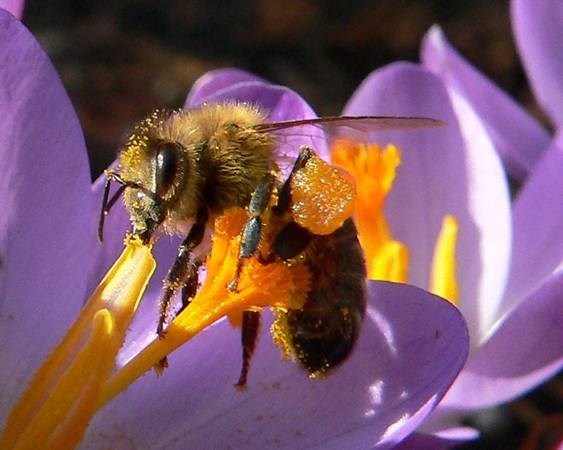Bees are an important aspect of our ecosystems. We know that we need to improve the conditions for bees, which in turn improves the conditions for survival of people. In Saskatchewan, many of our crops depend on bees for pollination and we also produce approximately 25 per cent of Canada’s honey.
Pollination is needed for plants to reproduce, and many plants depend on bees or other insects as pollinators. When a bee collects nectar and pollen from the flower of a plant, some pollen from the stamens — the male reproductive organ of the flower — sticks to the hairs of her body. Bees are drawn to plants with open or flat tubular flowers with lots of pollen and nectar. The scent of the flower and the bright colours also help to bring the bees in. Flowers visited more often by bees will produce larger and more uniform fruit. There are other pollinators in nature including wind, birds other animals and sometimes water, but bees and also other insects are the most valuable pollinators.
Every individual can contribute to the preservation of bees and other pollinators. If you are a beekeeper, you are particularly concerned to ensure you can keep your bees healthy and productive from early spring until you close down the hives in fall. In order for bees to be the most productive, a diverse environment is necessary. A diverse environment contains trees, shrubs, perennials and annuals so there is always cover on the ground and there is always something growing. This is the environment that will give you the longest season for honey production.
Some plants are magnets for bees such as summer flowering annuals like borage, bee balm, heliotrope, sweet clover and lavender. Perennials such as prairie crocus, chives, joe pye weed and salvia also fit the bill. Be sure to include one or two spring flowering fruits in your garden ‑ raspberry, cherry, apple, chokecherry, plum and saskatoons are delicious as far as bees are concerned.
Bees need to feed in early spring too. It may surprise you that early-blooming willow is a major food source for bees. There are also those pesky dandelions that grace our lawns just as the grass is greening up. We’re not suggesting that you grow a crop of them, but at least they are good for something. Bees just love them and this is another reason to keep herbicides off your lawn. Late summer blooming sunflowers, chrysanthemums and asters complete the season to keep bees fed until fall. Almost any flowering plant you grow in your garden will benefit bees.
If you would like to learn more about how to plant for bees or perhaps are interested in looking into keeping your own bees, be sure to sign up for the free online, interactive presentation hosted by Orchid Horticulture, sponsored by Grassland Honey and endorsed by the Saskatoon Bee Club. We hope this sharing of information will help new beekeepers learn more about what to plant to keep their hives producing and to help all of us learn more about what we can do to promote the health of bees in our environment.
Just in case you are interested, Grassland Honey still has some nucs for sale. They will be in a five frame cardboard nucleus box (two brood, two honey and one drawn comb for laying) and will be inspected by the provincial apiculturist. All spring treatments will be completed.Price is $260. A $60.00 deposit confirms your order. If you are interested or have questions call or text 306-380-4457 or get more details at .
Hanbidge is the lead horticulturist with Orchid Horticulture. Find us at ; by email at [email protected]; on facebook @orchidhort and on instagram at #orchidhort.




